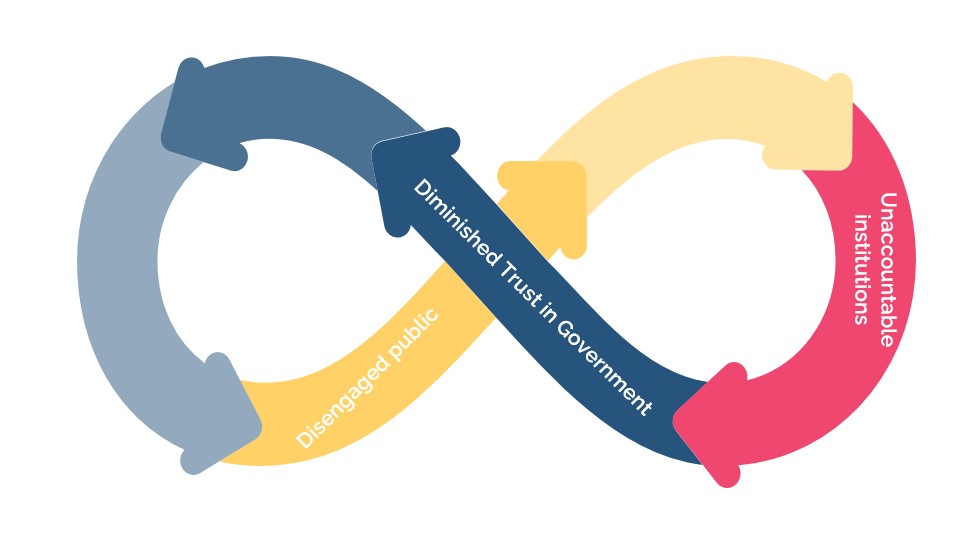
Photo credit: Assistant Secretary for Preparedness and Response, National Disaster Medical System
| While the word “trust” can have many definitions and meanings, for this report, trust in government is defined as the public’s perception of government based on expectations of how it should operate. Trust is the public’s belief that the federal system and the politicians who lead or oversee it are “responsive and will do what is right even in the absence of scrutiny.” |
|
Trust is crucial for reasons both conceptual (the legitimacy of well-functioning democracies relies on trust) and practical (government needs to be trusted so it can effectively serve the public). Yet most people in the United States do not trust the federal government.
| A lack of trust has serious consequences for the country. When people don't trust their government, they are more likely to opt out of voting and other types of civic participation. People who distrust the government are less likely to follow public health guidelines. For example, almost half (46%) of the people who said they were vaccinated against the COVID-19 virus trusted the government compared with 29% of those who had not been vaccinated. In fact, a recent study published in The Lancet found that countries with higher levels of government trust had lower infection and fatality rates during the COVID-19 pandemic. |
HOW DID WE ASK ABOUT GOVERNMENT?
A major goal of this research was to learn how the public thinks about various components of the federal government along with its views of the federal government as a whole.
In both the focus groups and the survey, participants were asked to concentrate on parts of the government using specific language. Some questions were asked about the “federal government in general,” while others were asked about parts such as “Congress,” “federal agencies” and “non-elected federal employees.”
|
In order to be strong and sustainable, a democracy needs diverse groups to engage and voice their preferences. This is possible only when people representing various communities trust the government to listen and respond.
With less engagement, the public feels less empowered to influence government. This creates a mistrust loop: Diminished trust in government leads to a disengaged public, which leads to inefficient and unaccountable institutions, which leads to further deterioration of trust. When that loop is activated, progress slows down.
| Our government is uniquely positioned to perform functions that are critical to national security as well as public safety and the well-being of the public. Low trust is a barrier to our government’s ability to meet today’s urgent needs and provide modernized, equitable and accessible services. |
 Click to enlarge. Image design by Slidesgo and Freepik. Click to enlarge. Image design by Slidesgo and Freepik. |
Distrust also can dissuade young talent from entering the federal service—an issue that will become increasingly important in light of a rapidly aging workforce. It may likewise impact the willingness of potential political appointees to serve.
Low levels of trust in major institutions—particularly the federal government—is a persistent problem in the United States. According to many organizations tracking this trend, trust in government has been in decline since the 1960s. But the past few years have added new layers of complexity to this issue. A public health crisis, widespread misinformation, protests and social unrest around racial inequity and the Jan. 6, 2021, insurrection at the U.S. Capitol reflected the brittleness of the public’s faith in democratic institutions. Particularly at this time, it is critical to examine the issue of trust, to fully understand how Americans feel about their entire federal government—not just elected leaders, Congress or even the government in Washington, D.C.—and to find ways to reverse the decades-long trend.

How this research is unique
Most surveys on trust in government measure its level, but many lack additional insight on drivers of trust, the specific sources of positive or negative sentiments, changing expectations of government, or potential means of restoring trust. Simply tracking the decline of trust in government as a single institution—dozens of agencies, over 2 million employees with differing mandates and a $6 trillion budget—and comparing it to years past is insufficient for the current state of affairs. What is needed is an investigation reflecting the current cultural moment and a deeper understanding of how government should be present in people’s lives.
Through interviews, focus groups and a nationally representative survey, we uncovered unique insights into how people feel about the government and the causes of those feelings. The results show that trust in government is problematic. However, when opinions are considered in their entirety, it is not all bad news for the federal government. When asked about specific agencies, services, missions or federal employees, the public’s views are more positive. People also feel that their personal experiences with the government are more favorable than not.
These findings suggest there are opportunities for the federal government to improve its brand by focusing attention on the executive branch institutions which, despite making up the vast majority of government, do not often come to mind when people think of government.
Trust in government should not be a partisan issue. It is an essential part of maintaining a democracy that works for all people. Trust is also essential for the government to be able to reform itself and improve its own functioning. It is not about building a bigger or smaller government but an effective one, well-equipped to solve major problems facing the country.
HOW DO THE PARTNERSHIP’S SURVEY RESULTS COMPARE WITH OTHER SURVEYS?
Many institutions have conducted surveys on how much the public trusts the federal government. The Partnership’s survey shows that 40% of the public trusts the federal government “a lot” or “somewhat.”
The wording of a survey question has an impact on results. For example, there is preliminary evidence that including the word “Washington” in a question rather than “federal government” might decrease people’s reported levels of trust.
For more than 40 years, Gallup has been asking: “How much trust and confidence do you have in our federal government in Washington when it comes to handling [International/Domestic] problems?” In September 2021, 39% of the public said it trusted the government “a great deal” or “a fair amount” to handle international problems, along with the same number for domestic problems.
The Pew Research Center asks: “How much of the time do you think you can trust the government in Washington to do what is right?” In April 2021, 24% of people said “about always” or “most of the time.”
The options respondents can choose from can also have an impact on results. While various surveys might come up with slightly different numbers, all point to strong levels of distrust in the federal government.
|
This report offers details about the level of trust in government among specific populations, as well as insights into why people feel the way they do. The topics discussed below include:
- Differences by demographics. How levels of trust differ by groups of population such as race, gender and age.
- Reasons why people distrust the federal government. Insights into potential causes behind varying levels of trust.
- People and institutions viewed positively. The public supports certain parts of the federal government.
- Improving the brand and trustworthiness of the federal government. What the public wants from its government and potential ways for the government to better itself.










